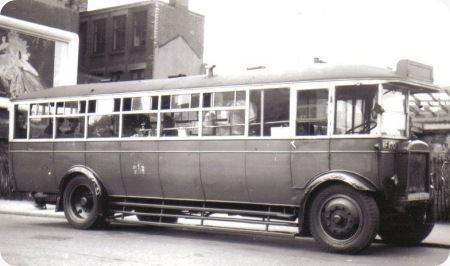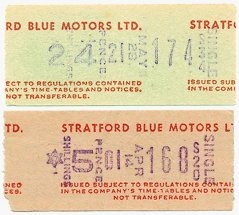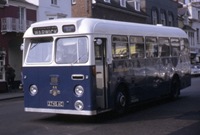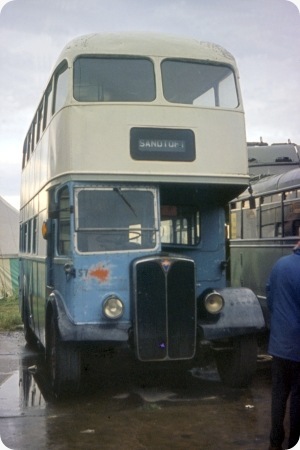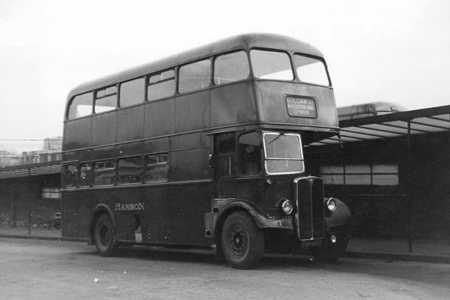East Yorkshire – Leyland Lion – WF 1170 – 97
East Yorkshire Motor Services
1928
Leyland Lion PLSC3
Leyland B32R
Photograph shows an all-Leyland Lion PLSC3 which was new to East Yorkshire Motor Services as its fleet number 97 in 1928. It is seen here in a later life as a Mobile Canteen for Sheffield Transport Department crews. The Sheffield coat of arms can be seen on the side panel and the tea-making equipment can be seen inside.
Sheffield has a long history of giving withdrawn buses an extended life as gritters, tow-trucks, overhead works towers, mobile libraries, etc but it is unusual to have taken a vehicle from another operator for these purposes. My Sheffield records are very extensive and I can find no record of this having been used as a service bus and conclude that it was bought from EYMS for the job it can be seen doing so well.
Photograph and Copy contributed by Les Dickinson
17/07/12 – 17:49
"Sheffield", Philip Battersby (Super Prestige) has a picture of Regent III/Roberts 122 on page 66. In the same picture, behind it, is "the Department’s mobile staff canteen which was in use from 1943 to 1958. VO7445 had been converted from the all Leyland Lion LT3 acquired from the War Department. (Never checked but there seem to be echoes of Underwood’s or East Midland in that number.) Whatever, it shows a track record of buying from outside for this sort of vehicle. [Come on, out there, someone knows the provenance of VO 7445.]
David Oldfield
17/07/12 – 17:49
This certainly seems to be an oddity, Les, as my records show WF to have been a Sheffield mark. East Yorkshire, being based in Hull (sorry, Kingston Upon Hull to give the correct title) would normally be expected to use marks from the local issuing Authority, not ones from elsewhere – even other areas within Yorkshire.
Pete Davies
17/07/12 – 18:28
Pete. WF was only a Sheffield mark after the 1974 re-allocations, when many local offices were closed. In 1928 Sheffield marks would have been W, WA, WB, WE, WJ, and would be until 1974.
David Oldfield
17/07/12 – 18:29
WF was only a Sheffield registration after 1974, before that it was East Yorkshire. An odd co-incidence really. WG also made the same move, this time from Stirlingshire.
David Beilby
17/07/12 – 20:56
I stand corrected! Thanks for the update.
Pete Davies
17/07/12 – 20:58
WF 1170 wasn’t a loner in the EYMS fleet but part of a batch starting, I think, somewhere about WF 1152 (fleet no 79 to WF 1171 (98). There were many other, unrelated WFs as well as these Lions.
VO was, as Dave Oldfield suggests a Mansfield, or Nottinghamshire reg, so maybe it was with one of the smaller operators in the East Midland area?
Les Dickinson
18/07/12 – 08:04
I’ve just realised one of the reasons the registration on the Lion feels odd is that it was an East Riding mark, whereas all the fleet I knew had Hull registrations.
David Beilby
18/07/12 – 10:01
According to the PSV/OS fleet history no. 97 (WF 1170) was withdrawn in 1939 and sold to the War Department in August 1940 and had passed to Sheffield by July 1945.
27 buses delivered in 1928 to EYMS had WF registrations, the first to have Hull registrations being sixteen Tilling -Stevens nos 104 to 119 (KH 6971 to 6986) also in 1928. Thereafter all new buses seemed to have Hull registration marks. 97 was one of several buses on hire to the South Staffordshire Regiment, Welton in June/July 1940 before being requisitioned by the War Department. It was last licensed by Sheffield in July 1955.
Malcolm Wells
18/07/12 – 10:02
Sorry to throw a spanner into the works over the registration letters WF, but, as David B points out, this was an East Riding mark, not Kingston Upon Hull. EYMS always used Hull registrations – AT, KH and RH. Some of their vehicles did have WF registrations, (along with BT, the other East Riding letters), but these came from acquired businesses such as Everinghanm Bros. Therefore, if this vehicle was indeed delivered new to East Yorkshire, its acquisition of WF letters, as well as the other vehicles Les mentions, would be a stark anomaly. It still just doesn’t sound right.
Changing the subject – I’m no expert on Lions or Leyland bodies, but doesn’t the driver’s door seem a bit far back for the steering wheel? Or is it just the angle of the photo?
Roy Burke
18/07/12 – 10:08
Keith Eastons excellent fleet list for East Yorkshire Motor Services Part 1 – 1926/1941 can be viewed at this link.
Peter
19/07/12 – 07:40
There is no anomaly. EYMS’s first buses that were ordered (other than acquired from former companies) in 1927 were 59-64, also Leyland PLSC3, which were registered WF 810/29/30/45/46. Also in 1927 nos 26-30 also PLSC3 had WF registrations but had been ordered by Lee and Beulah so it may be that whoever was in charge simply followed on using WF
Clearly EYMS did not always use Hull registrations – only with the arrival of 104 to 119 were Hull’s marks first used and of course continued to be used.
Remember that EYMS was newly formed in 1926 and had inherited several companies and premises and it is possible that it took time to sort out its approach to registrations. Several premises until 1929 were outside the city including the works and offices at Anlaby Common until Offices were opened in Hull in 1927.
See also pages 10 and 11 in the excellent John Banks book, page 16 in the Ian C Gibbs book and page 12 in the Keith Jenkinson book.
Malcolm Wells
19/07/12 – 07:41
East Yorkshire used East Riding registration marks (WF) during 1926/7 from then onwards Kingston upon Hull marks were normally used (RH, KH, AT)
Keith Easton
19/07/12 – 17:13
Thanks, Peter, Malcolm and Keith for putting me straight. I stand well and truly corrected – not for the first time, but, as my old Dad used to tell me, if you’re always frightened you might be wrong, you’ll never open your mouth.
Roy Burke
20/07/12 – 15:58
With respect to the above photograph of the former Sheffield mobile canteen bus, WF 1170, I wondered if the attached copy of the vehicle’s registration card might be of interest. It even records the unladen weight of 5-2-2, including benches, tea urns, and water tank etc!! Click this link to view
Remember Ctrl+ to zoom in Ctrl0 (zero) to get back.
Dave Careless
21/07/12 – 07:40
That is a great posting, Dave Careless. Thanks for sharing it.
Les Dickinson
21/07/12 – 12:14
Superb piece of history, Dave C.
Love the Tons/Cwts/Qtrs/Lbs. What a nuisance metric calculations are, compared with simple Imperial!
Chris Hebbron
23/07/12 – 18:34
Glad you enjoyed it; I like your comment about Imperial vs Metric, Chris, quite funny. Hard to imagine that by the time this vehicle was finally withdrawn, tea was probably still only available in loose form; I wonder how many cwts of tea leaves it got through every week ?!!
Dave Careless
21/09/21 – 05:49
Further to my post of 19/7/12, (9 years ago!) concerning the registration of East Yorkshire buses, as has been correctly pointed out, both BT and WF were East Riding marks.
No 20, which is usually credited as a part of the Lee & Beulah fleet, was actually purchased by East Yorkshire, but due to L&B being situated at Brough in the East Riding, it acquired an East riding BT registration. It would appear that the new company, although being situated in Kingston upon Hull, still registered in the East Riding for a couple of years, subsequently registering future vehicles in Hull.
Part one of the PSV Circle history of East Yorkshire covering 1926 to 1987 (privatisation) was published in 2018, part 2 (1987 to 2018) is still awaiting further developments.
Keith Easton
Quick links to the - Comments Page - Contact Page - Home Page
